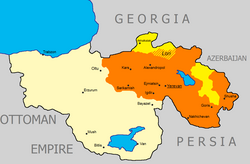Our website is made possible by displaying online advertisements to our visitors.
Please consider supporting us by disabling your ad blocker.
First Republic of Armenia
Republic of Armenia Հայաստանի Հանրապետութիւն | |||||||||||||
|---|---|---|---|---|---|---|---|---|---|---|---|---|---|
| 1918–1920 | |||||||||||||
| Anthem: Mer Hayrenik | |||||||||||||
 Territory held by Armenia and the Karabakh Council at some point Territories of Armenia Occupied by Neighboring States Area given to Armenia by the Treaty of Sèvres, which was not ratified and never entered into force.[1] | |||||||||||||
| Capital | Yerevan | ||||||||||||
| Common languages | Armenian | ||||||||||||
| Religion | Armenian Apostolic | ||||||||||||
| Government | Parliamentary republic | ||||||||||||
| Prime Minister | |||||||||||||
• Jun 1918–May 1919 | Hovhannes Kajaznuni | ||||||||||||
• May 1919–May 1920 | Alexander Khatisian | ||||||||||||
• May–Nov 1920 | Hamo Ohanjanyan | ||||||||||||
• Nov–Dec 1920 | Simon Vratsian | ||||||||||||
| Historical era | Interwar period | ||||||||||||
| May 28 1918 | |||||||||||||
| May 28, 1919 | |||||||||||||
• Sovietization | December 2 1920 | ||||||||||||
| Area | |||||||||||||
| mid-1918 (after the Treaty of Batum)[2][3] | 11,000 km2 (4,200 sq mi) | ||||||||||||
| 1919 (after the Armistice of Mudros)[4] | 70,000 km2 (27,000 sq mi) | ||||||||||||
| 1920 (per the Treaty of Sèvres; never realized)[5] | 160,000 km2 (62,000 sq mi) | ||||||||||||
| Population | |||||||||||||
| 500000 | |||||||||||||
• 1919 (after the Armistice of Mudros)[4] | 1300000 | ||||||||||||
| Currency | Armenian ruble | ||||||||||||
| ISO 3166 code | AM | ||||||||||||
| |||||||||||||
Preview warning: Page using Template:Infobox country with unknown parameter "longm"
Preview warning: Page using Template:Infobox country with unknown parameter "region"
Preview warning: Page using Template:Infobox country with unknown parameter "continent"
Preview warning: Page using Template:Infobox country with unknown parameter "latNS"
Preview warning: Page using Template:Infobox country with unknown parameter "longEW"
Preview warning: Page using Template:Infobox country with unknown parameter "country"
Preview warning: Page using Template:Infobox country with unknown parameter "latd"
Preview warning: Page using Template:Infobox country with unknown parameter "longd"
Preview warning: Page using Template:Infobox country with unknown parameter "latm"
The First Republic of Armenia, 1918–1920, was the first modern establishment of an Armenian republic. The country was created after the Russian Tsarist empire that began with the Russian Revolution of 1917 that lost power. Its creation with borders were the Democratic Republic of Georgia in the north, the Ottoman Empire to the west, the Persian Empire to the south, and Azerbaijan Democratic Republic to the east.
- ↑ Hille, Charlotte Mathilde Louise (2010). State Building and Conflict Resolution in the Caucasus. Leiden, Netherlands: Brill. p. 151. ISBN 978-90-04-17901-1.
- ↑ Hewsen, Robert (2001). Armenia: A Historical Atlas. Chicago: University of Chicago Press. p. 235. ISBN 0-226-33228-4.
- ↑ Walker, Christopher J. (1990). Armenia: The Survival of a Nation (revised second ed.). New York: St. Martin's Press. p. 257. ISBN 9780312042301.
- ↑ Chiclet, Christophe (2005). "The Armenian Genocide" in Turkey Today: A European Country? Olivier Roy (ed.) London: Anthem Press. p. 167. ISBN 1-84331-173-9.
- ↑ Hakobyan, Tatul (9 August 2015). "Sèvres: The Unfulfilled Armenian Dream". ANI Armenian Research Center. Archived from the original on 9 February 2018. Retrieved 1 December 2017.
If the Treaty of Sèvres had been realised, the Republic of Armenia would have covered a territory of over 160 thousand square kilometres.
Previous Page Next Page
جمهورية أرمينيا الأولى Arabic جمهورية ارمينيا الاولانيه ARZ República Democrática d'Armenia AST Ermənistan Demokratik Respublikası AZ ارمنیستان جومهوریتی (۱۹۱۸-۱۹۲۰) AZB Рэспубліка Арменіі BE Република Армения (1918 – 1920) Bulgarian República Democràtica d'Armènia Catalan Arménská republika (1918–1920) Czech Demokratische Republik Armenien German




